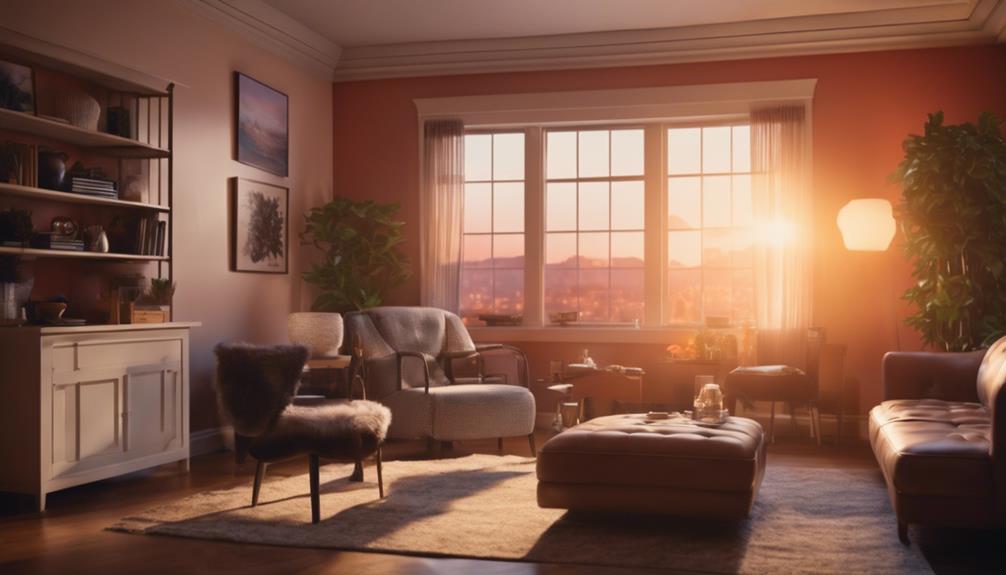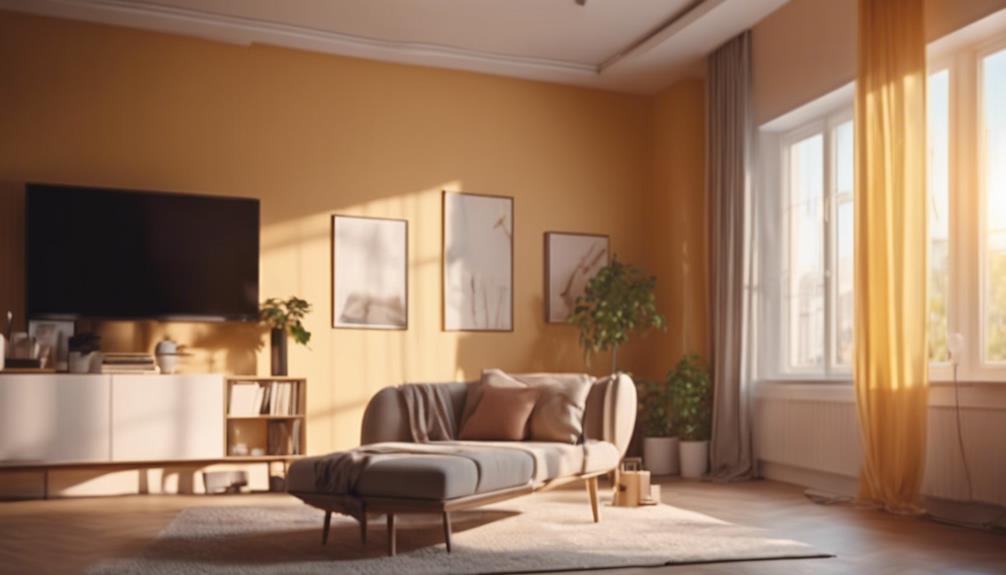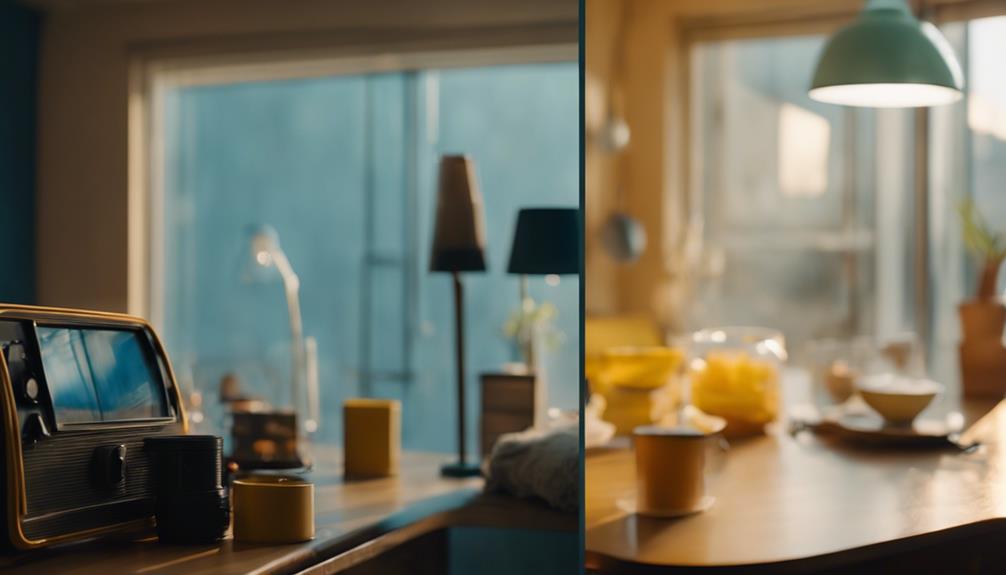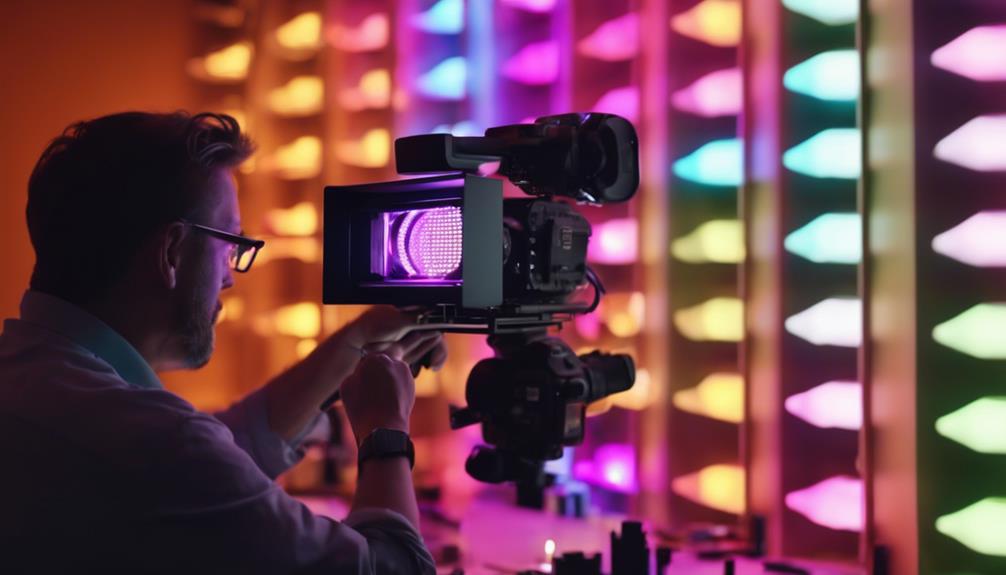Lighting is like magic for your room colors. It changes how colors look throughout the day. Imagine a room with a south-facing window, it's going to make light colors like blue pop out more. On the other hand, rooms with north-facing windows need warm colors to balance the cool light.
Not just natural light, but even the bulbs you use can change how colors appear. A bulb like incandescent or halogen can make colors look different. And don't forget about the type of paint you use. Whether it's shiny or dull also changes how the color looks.
If you want to become a pro at using light and color in your rooms, you need to learn more about things like color temperatures. You could even talk to experts who know a lot about lighting. This can help you really make your rooms look amazing.
Key Takeaways
- The kind of sunlight that comes into your room can change how the colors look. The direction of your window and the time of day can make the room feel different.
- Rooms with windows that face the south look best with light, breezy colors like Pavilion Blue and Borrowed Light, and soft neutrals like Joas White.
- Rooms with windows facing north or west need you to pick colors carefully. This is because the sunlight in these rooms can seem cooler and bluish, and changes throughout the day.
- The kind of artificial light you use can really change how colors look in a room. This includes things like the color temperature and the Color Rendering Index (CRI) of the light.
- The finish of the paint, whether it's shiny like gloss or flat, can also change how colors look. Glossy paint can reflect light and change how you see the color.
Understanding Natural Light Effects
Let's dive into how natural light affects the look of your room. It's like a hidden magic trick! It can change the way colors look in a room and determine how it feels.
Think about a shade of yellow. In a room with a window facing the south, it can be bright and lively. But in a room with a window facing the north, it might look dull. Pretty cool, huh?
Now, picture this. Your room that faces the east can become a snug hideaway in the morning when the light is warm and golden. On the flip side, a room facing the west gets to soak up the stunning evening light, which makes warm colors in your room pop even more. The different light at different times can switch up how colors look and set the mood of your room.
However, rooms that face the north can get a cooler, bluish light. This can make colors look a bit dimmer. But, it's not a bad thing! It gives you a chance to use cooler colors that might seem too strong otherwise.
South Facing Rooms Color Schemes
Hey there! We're about to dive into the world of color and light. Have you ever noticed how certain rooms in your house get more sun? Well, those are your south-facing rooms and they're kind of special. Why? Because the sunlight they get can change how colors look in the room. Some shades might look brighter, others might seem softer.
But don't worry, we're here to figure out which colors work best in these sun-soaked spaces!
Now, here's the thing: sunlight can make your room feel different depending on the color you choose. Warm, sunny spots can feel cozy and inviting with the right colors. So, let's find out how to use the natural light to make your room feel just the way you want it to.
Light Impact on Colors
South-facing rooms get lots of sunlight all day. This makes them great for light, airy color schemes that make the room seem bigger and more open.
Choosing colors that reflect light, instead of soaking it up, can help make the room brighter. For example, blues like Pavilion Blue or Borrowed Light can make the room feel peaceful. Warm neutral colors like Joas White can give a cozy vibe.
Remember your woodwork too – a bright white can make the room look crisp and new. So, have fun experimenting with light and color to make your south-facing room really pop!
Best Colors for South-facing Rooms
South-facing rooms receive abundant sunlight throughout the day, necessitating a careful selection of colors to enhance the brightness and create a welcoming ambiance. Light, soft colors are ideal for this purpose, such as Pavilion Blue and Borrowed Light, which impart a sense of calm and serenity to the space. For a warmer feel, consider Joa's White, known for its ability to create a cozy atmosphere. Additionally, using bright white for trim can further amplify the room's brightness and cleanliness. By choosing these colors thoughtfully, you can ensure that your south-facing rooms feel inviting and pleasant to inhabit.
Utilizing Natural Light
Use the sunshine that pours into your rooms facing the south to give life to your space. The amount of light can change how colors look, so keep this in mind when picking your color scheme.
Light colors like Pavilion Blue and Borrowed Light will look even brighter, taking full advantage of the sunshine. Warm neutral colors such as Joas White create a comfy feeling, ideal for a sunny morning.
Even though dark shades might look more intense, you can use them effectively with a good mix of natural and room lighting. Add a little sparkle with bright white trim and light bulbs that glow like a candle for a neat and fresh look.
Always remember, the way sunlight interacts with color plays a big role in designing your perfect room.
North Facing Rooms Color Schemes
Picking the right colors for your room that faces north can really change how it feels. These rooms tend to get a cooler, bluish light which can change how color looks on your walls. You'll want to avoid green or grey colors because they can look dull in this kind of light.
A good choice for these rooms are colors with a yellow base, like Yellow Ground. These colors reflect light well and can make the room feel more welcoming and bright. It's all about making your room feel like a cozy part of your home, and the right colors can help with this.
You don't have to be scared of the cool light in these rooms. Using dark colors, like the elegant shade Railings, can give the room a snug, comfortable feeling. The idea is to work with the natural light, not against it, to make your home look its best.
Another handy tip for north-facing rooms is to use mirrors. If you put a mirror in the right spot, it can reflect the light and make the room even brighter. It's all about using what you have to make a space you really like.
Color Shifts in West Facing Rooms

As the day goes by, the sunlight in your room that faces west changes a lot. It's like a cool light show that you can control.
You can pick colors for your room that look great with the afternoon sun or make the morning feel warmer. You can even use shadows to make your room look more interesting.
They can bring your room's color to life in a cool way.
Afternoon Light Impact
If your room faces west, you'll see cool lighting tricks throughout the day. In the afternoon, the light gets a gold hue, making colors like pink brighter. It also changes the look of light blue, giving your room a different feel.
This means you need flexible colors in a west-facing room. Colors like Slipper Satin or Shaded White can handle the cool morning light and the warm afternoon glow. Knowing how light changes the way we see color is important for making your room cozy.
Enjoy the cool mix of light and color, and love your unique west-facing room.
Selecting Appropriate Hues
Choosing the right colors for your room is important. Especially for a room that faces west, as the light changes during the day.
When you're picking paint colors, think about what time it is. In the morning, rooms that face west have a cooler light. So, colors like Slipper Satin or Shaded White can help make the room feel less chilly.
As the day goes on, your light bulbs will give off a warm light. This is a great time for a color like Middleton Pink. It can stand up to the bright light and really shine in the afternoon's warmth.
If you want a color that changes a bit during the day, try something like Light Blue. It's fun to see how these colors change with the light.
Picking the right color can make your room feel just right and be a place where everyone feels welcome.
Managing Shadow Effects
Playing with shadow effects in a room that faces west can be really fun. You can use colors to change how the room feels from morning to night.
For instance, using a color like Middleton Pink can make your room feel warm and cozy when the sun starts to set. To balance the light in the morning and evening, you could use colors like Slipper Satin or Shaded White.
Light Blue is also a great color that can adjust to the changes in light throughout the day. The main idea is to pick colors that work well with different levels of light, helping you handle the color changes in your west-facing rooms.
East Facing Rooms and Color Perception

If you have a room that faces east, you're in luck. These rooms catch the most morning sunshine, and the color you paint them can affect how the room feels.
Imagine how calm a room can be with light blue or green on the walls. It's like having your very own peaceful spot to start your day.
Dark colors have their charm too. For example, a color like Inchyra Blue can make your room feel cozy and safe, like a warm hug.
Want your room to feel alive with energy? Try bright colors like Whirlybird. They'll make the sunlight seem even brighter.
Impact of Artificial Lighting
Artificial lights, like the ones from light bulbs, can change how colors look in your room. There are many kinds of light bulbs – like incandescent, fluorescent, and halogen. Each one makes colors look different.
For example, incandescent bulbs, the kind you might've in a desk lamp, give off a warm light. This makes warm colors look even warmer, which can make a room feel cozy and welcoming. But it might also make cool colors look less bright.
Fluorescent bulbs, like the ones you see in offices or classrooms, create a cool, blue light. This type of light makes cool colors look bright and fresh.
One thing that's important to know is the Color Rendering Index (CRI) and color temperature of your light bulbs. These things help you understand how true to life the colors will look under your lights. You want to choose a light bulb that will show the real beauty of your room's colors.
Another thing to think about is shadows. The shadows made by your lights can make colors look different in different parts of your room. This can add depth and change how colors are seen overall.
Decoding Color Temperature and CRI

Understanding color temperature and CRI can help you make your room look really cool! Color temperature talks about how warm or chilly a light feels. Lights with lower temperatures feel cozy and warm, like a fireplace. Lights with higher temperatures feel cool and active, like a winter day.
Then, there's this thing called CRI, or Color Rendering Index. It shows how accurately a light can show the real colors in your room. When the CRI value is high, the light is better at showing off your room's colors under artificial light.
Knowing what color temperature and CRI are helps you choose the best light bulbs for your room. For example, if you want to bring out the warm colors in your room, you can use a warm white bulb with a low color temperature. If you want to highlight the cool colors, a cool white bulb with a higher color temperature would be a good choice.
Choosing the right balance of color temperature and CRI isn't only about making your room look good, but also about making you feel comfortable and at home. The perfect light bulb can make your room's colors stand out, making your room not only look great but also feel like your own special space.
The Role of Paint Finish
In the world of room decoration, the type of paint finish you pick is super important. It can really change how your room looks and feels. You have two main options: glossy or flat finish. Glossy finish is shiny and can bounce light around. This might change how your room's color looks.
Flat finish, on the other hand, doesn't reflect as much light. This means the color you see is more true, no matter the light. It's like a game of color and light! Simple colors like white or off-white are good because they work in different lights, giving the room a peaceful feel.
But watch out for bold colors like khaki, sage, or taupe. They can look different depending on the light. If you want to play it safe, go for light shades. They stay the same in different lights, helping you set the right mood in your room.
Consultation With Lighting Experts

Once you've picked your wall color, it's smart to get some advice from people who really know about lights. They can show you how different types of light will make your color look different. Talking to these light pros can help you figure out what kind of light is best for your room.
These people know a lot about things like color temperature and CRI ratings and can explain them in a way that's easy to understand. They can help you pick the right light that will make your room look its best and not mess up the colors you've chosen.
They can suggest lighting that goes well with the color you've painted your room. They'll think about how much sunlight your room gets and offer options that will make your room look great.
Getting tips from lighting experts can make your room feel cozy and like it's really yours. Working with them can help you make sure your room colors look great and create a space you'll love. So, why wait? Get in touch with a lighting expert today and they can guide you on this bright adventure.


Leave a Reply